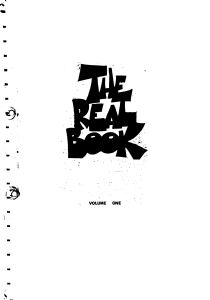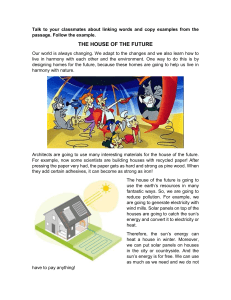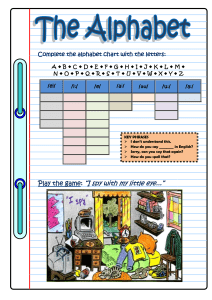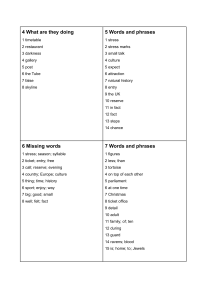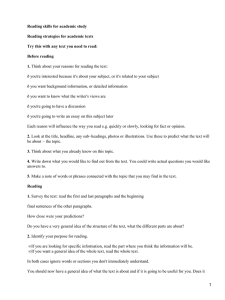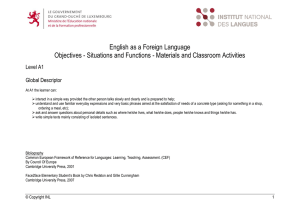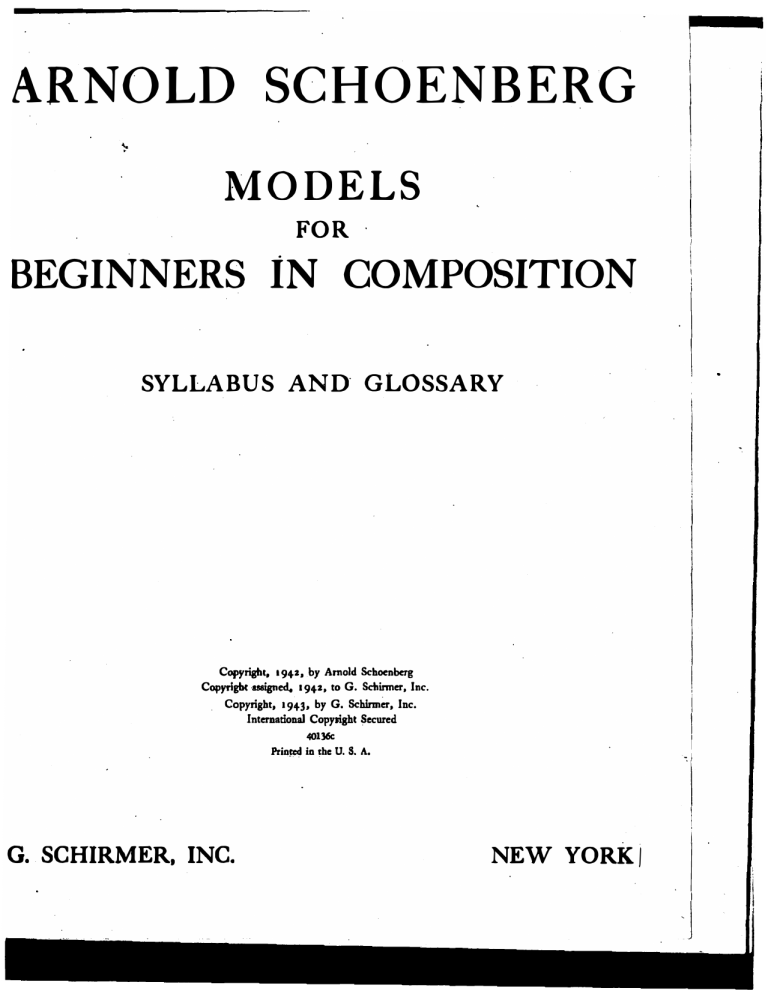
ARNOLD SCHOENBERG
MODELS
FOR ·
BEGINNERS
iN COMPOSITION
SYLLABUS AND' GLOSSARY
Copyright, 1942, by Arnold Schoenberg
Cop}'!'lght ·assigned. 1942, to G. Schinner, Inc.
by G. Schirmer, Inc.
Internadonal Copyright Secured
. Copyright, 1943,
40136c
PrinJed
G. SCHIRMER. INC.
in the U. S. A.
NEW YORK}
I .
p
PREFACE
This is the second, revised and enlarged version of a syllabus which I prepared
beginners in composition in a summer session of six weeks at the University of Californi
Los Angeles.. Though the first version was done in a great hurry and at a time wh.
was o�cupied with other affairs (composing, for instance, which is not a mere avoca
of mine), and though I anticipated that I could perhaps teach some theoretical knowIE
but not much technical skill, I was surprised by the success of this syllabus. It he]
my students to such an extent that even those with little creative ability and music
ship could write a small minuet or even a scherzo that was not quite impossible.
This success induced me to interrupt my work, again to sacrifice composing to te�
ing, in order to produce this second version, hoping to make it more useful and effectivt
The main objectives of this syllabus are: ear-training, development of a sens
form, and understanding of the technique and logic of musical construction.
Students who wish to become music teachers in colleges, high schools,or element
schools are required to study composition. But, according to my experience, very
can . write without the aid of the piano and even fewer possess a sense of the relation bet\\
melody and accompaniment. Besides, many of these students who might be good
strumentalists have no creative imagination, while often those who have talent th
that today one may write everything: they have heard even in popular music unrela
dissonances and think they can apply them as well in their attempts at composing Sf
but logically constructed forms.
Considering all these facts, I introduced several years ago a new method of achie\
coordination of melody and· harmony, which makes composing easier even to such studE
as have. no desire or ability for musical creation, and which has also proved to contrit
considerably to ear-training.
Great stress is laid in this syllabQs upon the concept of variation, because this is
most important tool for producing logic in spite of variety. Even a beginner who has
a considerable creative talent will be able tQ write at least as well as is needed for a "pass
grade" if he studies the manifold ways by which variation is applied to simple basic for
and if he then tries to employ similar methods in his own attempts.
He will observe that even a change of the harmony-successions demands adaptat
and thus produces new motif-forms. \ H� should study very thoroughly the Model�
Harmonies for Two-Measure Phrases. They reveal many ways of enriching the harmo
. and if he understands the principles involved there, he will be able to apply these meth
not only to phrases, but also to many other segments. This knowledge is very import
in producing cadences to various degrees and, in the "elaboration"-sectiori of the SChE
(see p. 11), in working out the "modulatory" harmony of the "models" and sequent
The student should become familiar with the "root progressions". which produce "rovil
harmony.
Of course, not all those technical problems are within the reach of a beginner. J
studying and analyzing the examples will make him acquainted with such procedures c
might stimulate a future composer to write in a more dignified manner.
The student will also have to study the same forms in works of the classic mast.
At first the 'study of Beethoven's piano sonatas is recommended , because his forms
[ 3 ]
4
PREFACE
generally simpler even than Mozart's or Haydn's. But the student must not be startled
if he finds in the works of these masters features that are not discussed in this syllabus:
in a brief course like this, it seems impossible to teach everything a maSter's imagination
and fantasy might invent. There are "irregularities" which are only accessible to a really
great';"talent, a higher technique, and-perhaps-only to genius. Besides, the student
should realize that these models show merely one way of approach to the technique of .
composing. .:Qu.t he should not in any case think that a composer would work in such a
mechanical manner. What produces real music is solely and exclusively the inventive
capacity, imagination, and inspiration of a creative mind-if and when a creator "has
something to express".
None the less, a student should never write mere dry notes.
try to "express something".
At all times he should
Marking tempo and character by such terms as cantabile,
agitato, con spwito, grazioso, playful, gay, 'lnvace, grave, ·etc., he may find that his imagina­
tion has been stimulated to make him produce pieces of a definite character such as a
song, an agitated allegro, .a witty scherzo, a graceful gavotte, or even a nocturne or a
rhapsody of vague, unidentifiable Ill:ood. Very early a student can thus write with more
spontaneity, which need not exclude conscious appiication' of his technical knowledge.
SYLLABUS
I
COORDINATION OF MELODY AND HARMONY
. In qrder to obtain coordination of melody and hannony the student will in his first
.!
exercises use only the tones of the underlyiDg harmODY_
Tones foreign to . the �naerlying harmony must be added to the tones of the broken­
chord forms only as passiDg'�otes, suspensions, grace notes, and other aUXl1jary notes,
according to the advice given under (c).and (d).
From the- very beginning all 'exercises should be canied Qut in several
' keys. Thus
the student will be at home in every key in a short time.
(A) BuUdln. Two-Measure M�tive8, or Phrases on a SInAle HarmOny
(a) In'Exx. 1-4 only broken-chord forms of the tonic are' used tn half- and quarter­
notes.
can.
The student should try to find as many different ways of
brMlrjug .. chord as
he
_
(b) In Exx. 5-11 the same and similar broken-chord forms are carried out in cWlereat
Tone repetitions contribute to rhythmic variety and often produce chara<-­
rh,tbms.
teristic features.
(c) A�ditioD of passing notes. In the beginning they.should preferably be used only
on the weak beat (Exx. 12-15).
,
(d) Auxiliary notes and other embeJJisbments are added to basic forms (Exx� 16-19).
A student should always try for rhythmic variety. It may well be that not every­
thing is "beautiful'·. or "melodious", or "perfectly balanced". * The teacher will correct
or ttOSS out the worst of his exercises and explain why they are too poor or overcrowded.
At first the only important thing is to Contrive as many different forms as possible. Incor�
porating thus the concept of variation and its technical possibilities in oile's mind will 'be
of great advantage when the student later tries to invent real melodies, instinctively and
spontaneously.
Observe the tWleren�e between the first and the second measure of, most of the
phrases. ·Generally the second will Contain fewer features and less movement than the
�t measure (Exx. 6, 8, 9,: 10. 12, 13, 16, 18).
(B) BuUdln. TWo-Measure Phrases on Two Harmonies
on I-V C,Exx. 20-29)
U I-VI
( .. 30-36)
U
I-IV ( U
17-43)
U
I-III (U 44-50)
..
I-II
In Exx. 34 and
(
"
51-57)
36; chromatics
are
inserted.
IIi Exx. 41 and 42. an artificial dominant seventh chord emphasizes the progresslon
.
towards IV.
Exx. 44-50 use m ill the form of an artificial dominant (seventh) chord. This is
especially advisable if the next measure should stcit't on VI or, by a deceptive cadence,
. on IV or II (�. 47a. 48a, 498).
-rbe aamplet. of this syllabus are aIaD lO1Iletimes linbalanced. or even do not sound melodious. They are not made for
beauty, but their parpoee i. adusively to show the appJicaticm, of technical methods.
IS)
6
MODELS it'OR BEGINNERS IN COMPOSITION
The n appears more frequently in its first inversion or as a I, t, or 2 chord. Beware
of parallel fifths if using the root position.
(C) Two-Measure Phrases Based on Three Harmonies.
These should also be practised as ' systematically as the preceding exercises. Some­
times, however, a student, even at t�is early stage, may have tried to "invent" such
forms instinctively. In any case, the rhythmical and motival features and fonnations
should stimulate him to produce material similar to that shown in the models.
Observe some of the rhythmic features, for instance the syncopations in Exx. 59,
64, 65, 79, and �3, and the augmentation of rhythmic features in Exx. 58, 61, 62, 67, 67a,
69, 75, and 76. Some of them are exact, some are free.
Again the treatment of the 'second measure should be studied. Its relation to the
first measure might be compared to the relation of a strong to a weak beat. But just as
a weak beat sometimes carries an accent, so a second measure of a phrase need.not always
represent a decline. Here one finds the augmentations mentioned abov�, and also re'
ductions-that is, the omission of subordinate features (Exx. 60; 66, 78, 80, 81).
Watch further the multiple use of motival features, marked a, ai, at, etc. Advice for
this technique might be' given as follows: If the rhythm is exactly or approximately the
same, the interval may be changed freely, because rhythm is more noticeable than int�r­
val. Often a rhythm is "shifted" from a strong to a weak beat and vice versa (Exx. 59,
65, 76, and 79).
(D) Two-Measure Phrases on more than Three Harmonies
A few examples are given in Exx. 86-93. It would be too difficult for a beginner to .
write such exercisef? in the mechanical manner of the preceding assignments. It will be
easier to.do that when he has digested the ways of, inserting "passing" harmonies shown
in Exx. 167-188. In studying all these models the student should realize that the basic'
assumption for richer harmony is a semi-contrapuntal movement of the bass, in -which
the other accompanying voices cannot fail to participate. It is the tendency of indepen­
dentvoices that produces a richer movement of the harmony. The alternatives 86a, 90a,
91a, and 93a show that even fewer harmonies would suffice.
Observe the (imitative) use of motival features in the accompaniment of Exx. 90
and 92.
II
MOTIVE AND MOTIVAL FEATURES IN TWO-MEASURE PHRASES
In phrases, motival features usually appear more than once. Thus a motive might
be established which in the continuation will appear in more and richer variations, developing more and other phrases and other segments of various size and function.
(A) Most of these phrases are merely variations of the primitive examples
of the
.
beginning. Thus 94 is built from 12; 95, 96, and 97 ate built from 13; etc�
(B) Various other Ways of Utilizing Motival Features
.
The student wHI observe that all these examples contain in one way or another the'
beginning three notes (or their rhythm) of Ex. 119. They appear in simple repetitions,
in transpositions, in inversions, in augmentations, shifted to other be;;l,ts, etc.
The student should apply all these treatments to his own exercises.
.
.
SYLLABUS
7
Many ()f these examples are unbalanced, at least without a proper accompaniment.
But Ex. 132, a variation of Ex. 131, is used later (Exx. 226 and 231) to build a sentence
and a period. It pays to try changes and variations of the kind indicated even if the.
result is very poor.
Th�examples 147 to 150 derive from the forms 140 and 141. There they are based
on I-V. But Exx. 148-150 use a much richer harmony, though they also begin on I and
end on V. But even examples like 130 and 144, distinctly overcrowded, can be of some
usefulness if treated like 130a and 144a.
(C) Some Models of'Accompaniment
In piano style the harmony need not be present in full at every beat. On the
contrary, if it is not for t� e expression of a certain character, the insertion of pauses in one
or more vo�ces will provide transparency and often produce a ch�racteristic "motive of
the ac�ompaniment", i.e., a'rhythmic pattern that should be used, with slight accommo­
dating alterations� in the continuation. Not only can such a model, even within one small
phrase, consist of different elements, e.g: Exx. 152, 155, 156·, 157, etc; but also one element
alone can be useful, e.g. the "march-like" forms of Exx. 158, 159, 161, and 163. Inde­
pendent movement of one or more .voices-if it does not interfere with the harmony· .
and even obscure it-is always valuable, for instance in Exx. 159, 164 (of which later a
sentence. and a period are built, Exx. 224 and 230), 165, and 166. Mostly the independence
of those voices is not considerable. They merely follow the movement of the melody.
Ex. 162a shows that this model could also be accompanied without such movement, but
Ex. 162b shows a freer treatment.
(D) Models of Harmonies for Two-Measure Phrases
Ex. 161 shows-in the beginninlJ systematically-some of the most dependable har- .
mony-successions. Attention is directed to the use of inversions of triads and seventh
chords and to the use of "transformations" of the chords on some degrees: artificial domi­
nants, diminished sevenths, etc. These transformations are produced by the. use of "sub­
stitute tones" derived from "related regions" of the key. The ex�mpies are based on Ustrong'" or "ascending" and "super-strong" root-progressions according to the model
V-I: V-III, and V-VI, V-IV, respectively. Of course, not everything possible could be .
included, though weak progressions are avoided. In minor especially not every progres­
sion might be usable.
Exx..172-�88 shbw how much such harmonies could be used in phrases. Much of
that will seem difficult to a beginner without a thorough knowledge of harmony. But
to understand the principles of such treatment will widen the-student's scope, even if only
.
the.oreticalIy"
Attention should be directed again to the accompaniment, to the frequently indepen­
dent movement of the voices, and to the fact that the rhythms of the harmonic pattern
.
might be altered.
III
SENTENCES
(A) First Four Measures only
W�at is here called the "dominant form" (measures 3 and 4) is in the most simple
cases a repetition of meas.1-2 accommodated to a contrasting harmony: Ex. 189, I con-'
8·
MODELS FOR BEGINNERS IN COMPOSITION
trasted with Vi Exx. 190 and 191 (and the alternatives 192-197)� I-V contrasted with the
reversed succession V-I. Even here the dominant form should not become merely trans­
posed. This is primitive and monotonous. At least such alt�rations as have been marked
by (+) are advisable. Of great interest are trarisformations like 193 to 197. Still more
interesting are repetitions like Ex. 198, in which meas. 3-4 are based on (II) ..V-I, a free
repetition of the I- (IV)-V of meas. 1-2. Sequential repetitions are also sometimes useful,
Exx. 200, 201, 205, �06. Of course, as there is here n� I-V relation, ,the term dominant
has to be understood in a metaphorical meaning.
(B) Completion of the Sentence (meas. 5-8)
The sentence-form which is taught here does not pretend to be more, than a
"school-form"; a way of dealing with an elemeJltary problem in 'a manner within reach of a
beginner. Nevertheless, it should be mentioned that there are many similar examples
in Beethoven. See, for instance, the Exx. 207-210, from his piano sonatas; even the first
theme of his Fifth Symphony uses this form.
It will not be too difficult to construct this form according to the following suggestion:
Measure 5 is usually a reduced form of the content of the first phrase. This. reduction is
achie�ed by omitting some features more or less subordinate (Ex. 212), or by connecting.
elements of the first phrase in a different manner (Ex. 213) or in a different order (Exx. 214,
215, 216). Measure 6 is generally a kind of repetition of meas. 5: a strict repetition
(Exx. 210, 211), or an accommodation to another degree (Exx. 207, 212, 213, 214, 215), or a
strict (Exx. 220, 221, 222, 225) or free sequential repetition. In contrast to that, in Ex.
223 only the motival "residues" of m:eas. 2 are repeated along a chromatic ascent in the
melody: D-D#-E-E#-F#;and Ex. 224 elaborates
elements of the basic measures above a
'
flowing succession of" h�onies.
Measure 7 prepares for the cadence on I (Exx. 220,' 223, 225, and 226), or V (Exx.
220, �nd ending, 221, 224), or III (Exx. 220,.3rd ending, 222, 227).
Observe the "condensation" of the" harmony in the cadential segment. There are
generally more harmonies used at this place than in the preceding measures.
Observe· also the treatment of the main voice in this segment. In general, further
reduced basic elements, above a moving harmony, pass into less obligatory forms. '
It might help the student to approach a solution of .these technical problems by writing
at first a great number of sketches, even mechanically, and then selecting the best ones.
While so doing he should often return to the methods of developing new motif-forms by
variation, as discussed in the beginning.
IV
PERIODS
The main difference and also, to a beginner, the main difficulty in writing periods
lies in the necessity of using in meas. 3-4 "more remote'" motif-forms. To all of the four
periods in Exx. 228, 229, 230, and 231 are added two alternatives: all of these periods end
on I, or on V, or on III. The use of basic intervals, marked i a I I at I I a2 i
a
at
a2
etc., and of basic rhythms, marked A A A. etc., illustrates the relation to the first
phrase. The student shouid analyze in order to acknowledge the "destiny" of the motive,
and try as many similar developments himself.
SYLLABUS'
9
b
': is used in a "chain-like" construction in
In Ex.. 228 the interval' of a fourth ,
measures 2-3 of the antecedent; the consequent uses only the up-beat and the rhythm.'
but employs many changes of the interval. This period is built from the motif No.8
on
'p. 41.
,
Inversion of a melodic part of the phrase (meas. 2-3 of Ex. 228b) can be recommended.
,
Observe in Exx. 230 and 230b, meas. 4, the shift of rhythm A,.: to the first beat.
Similar shiftings of intervals and rhythms are used in Ex. 231.
"
The caesura (meas. 4) and the ending (meas. 8) are chiefty produced by the harmony.
While the end (meas.8) is always carried out by a full cadence (IV-V-I or II-V..I, trans­
posed to the region in which one is at that moment), the caesura in ,meas.· 4 can
be approached by a half-cadence (IV-V·or II-V, or also VI-V). Generally in the measure
before the fi�al degree, one will already observe an enrichment of the harmony: more­
harmonies are usually used there than in the beginning.
Th� melody in. those cadential segmen*.f.,.moves with more richness than in the pre­
ceding measures. The caesura, furthennore, is usually characterized by a rest, at least
in the accompaniment, producing the effect that a comma or semicolon produces in
punctuation.
The consequent is usually a free repetition of the antecedent. However, one, two,
or even three measures could be exactly repeated. But in higher art mechanical repetition
"
is not too dignified-variety should always be the aim of a good composer.
In Exx. 228, 228a, and 22Sb, only the up-beat is repeated exactly, while all the rest
shows a new use and a rearrangement.
In Ex. 229 one full measure is usec;l, but the harmony is changed.
Two measures are repeated in the consequent of Ex� 230a. But 'Exx. 231 and 231a
start at once with derivatives of the basic features.
In general, in cadential segments (e.g. Ex� 232, meas. 7-8) the strict' use of motive
contour concludes this sectioDi
forms is abandoned (UliquidatedU) and a f"*f melodic
'
generally on V. sometimes on III.
V
CONTRASTING MIDDLE SECTION
of the Ternary (a-b-al) Form
The important problem in writing this section is to make it contrasting and coherent.
The decisive contribution to the contrast is made by the harmony. For this purpose
fortY-eight scheIt\es are to be found on pages 30-33. Some of them are too compliCated for
the first attempts of a beginner, but might be tried by a student who possesses considerable
skill in harmony. Some of them, which have been sta�ed (*), can be used not only in
major but also in minor. A.nd some 'of the schemes given in minor (42-48) can perhaps
even be'of use also in major (in C major or transposed).
Structurally the contrast will be achieved by using the motive forms or even new
derivatives from them in a different order. Observe, for instance, in Ex. 236 the shifting
' "
of the features A and 'A' of Ex. 229 to other beats, and the inversion of the interya1
C
lin meas. 10.
I
•
10
MODELS FOR BEGINNERS IN COMPOSITION
Exx. 238, 239, and 240 show more complicated forms in the harmony and in the
motival elaboration. They also u� semi-contrapuntal imitations of a prominent rhythm
in the accompanying voices.
VI
RECAPITULATION (a1)
J
II
The recapitulation (a1) of the "au section after the contrasting middle section may
in primitive cases consist .of a mere repetition, on condition that the first a-section
end on I. Thus a full a-b-al form could be composed' by adding to Ex. 220 (no matter
whether the first, second� or third ending was used) one of the' two contrasting middle
sections (Ex. 236 or 237) and thereafter simply repeating Ex. ·220 with the first ending on I.
The same would be right if Ex.221 or 222 would be used as an a-section. It would per­
haps be more interesting to use Ex. 22� as the ai-section in all these cases, because a varied
repetition is always more artistic than a literal one. Thus in masterpieces much variation, "
is often found in structure� harmony, accompaniment, and even in size, the segment being :
sometimes reduced (to six, four, or an uneven number of measures, see Beethoven's piano .
sonatas Ope 2, No.1, Adagio; Ope 2, No. 2, Rondo; Ope 7, Rondo; Ope 2, No.2, Largo, .
seven measures), or b�ing extended (to ten measures, Ope 7, Largo).
If the period Ex. 230 should be the a-section and Ex. 239 its contrasting middle section,
the recapitulation has to be composed anew, in order to end on I. This is carried out in
Ex. 241.
'
VII
MINUET
The form of the minuet is in most cases ternary. Sometimes one finds in claBSic
examples the contrasting middle section longer (6,8,or more measures) and more elaborate'
(Beethoven, Ope 2, No.2; Ope 10, No.3; Ope 22; etc.). Sometimes the recapitulation is
shortened (Op.31, No.3). Sometimes one finds the addition of one or more codettas in
the a-sections, or :of an episode iri the b-section. Irregular construction of phrases or
segments will also be found. The accompaniment has often a "stylized" touch of dance
accompan�ment. But this migh.t also occur in every other kind of ternary form.
The model given in Ex. 242 is complicated, harmonically and motivally. Especially
the contrasting middle section, which turns in meas. 11 to the region of subdominant minor,
might be interesting. Ob5erve, furthermore, that the recapitulation is extended to ten
measures and begins with a remote variation of th� first phrase in the left hand, to which
the right hand adds a counter-melody (compare meas. 10 to meas. 13), and that in measure
18 the feature d1 is detached from b2 and is used three times as material for the extension.
The alternatives (a), (b), and (c) show how the a-section could end on I or III, or
(with a half-ca4ence) on V. The alternative (d) offers' a different use of the material in
the contrasting middle section. The way in which this section is extended to eight
measures i� interesting and emphasize� the "up-beat harmony" (V) in two measures (1516). The following measures 13-20 bring a richly varied repetition of the a-section.
,
"
I
SYLLABUS
11
Ex. 243 shows that the antecedent, with slight harmonic changes, could end on V
instead of III, and that nevertheless meas. 5 could begin on VI.
Ex. 244 illustrates the use of a sequence (meas. 9-10 and 11-12) and, more interesting,
a procedure which is excellent in H:s effect: in meas. 13 and 14 the melody remains un­
changed while the harmony moves constantly.
VIII
SCHERZO
The form of the scherzo is also ternary and differs from the preceding a-b-a1 forms
only in its middle section, which is a modulatory contrasting middle section and is called
the elaboration. Its harmony, though roving (that is, moying from region [generally
miscalled "key' '] to region), does not fail to establish at the beginning of each segment (called
"model", "sequence", "red uction" , etc.) at least temporarily the tonic of a region or key.
Such points are marked by stars (*) in"Ex. 245 at meas. 9� 14, 19; in Ex. 246 at meas. 9,
13,17,19,21; in Ex. 248 at meas.-9 and 11; and in Ex. 249 at meas� 17,21, 25, and 27.
A "school-form" of the elaboration of the scherzo can be constructed by building a·
model of two or more measures, using motif-forms or·derivatives in a different order above
a preconceived' harmony-progression which leads to a region other than that of its
beginning. Generally its ending harmony should be suitable for introducing the sequence
which then follows (see Ex. 245, meas. 9-13; Ex. 246, meas. 9-12; Ex. 248, meas. 9-10; Ex.
249, meas. 17-20).
. The sequence. if it deserves its name, must be a complete and exact transposition to
another degree. But in selec�ing the transposition, the student should avoid deviati�g
too far from the related regions. For instance, in C major one would scarcely go to F# .
major or B{' minor or B major. But Beethoven in the Scherzo of Ope 2, No: 2, arrives at
G# minor in A major, which is quite far. A master may do this; a student would better
avoid it. Generally the model now undergoes a process of "liquidatiQl1", which is a method
of getting rid of the obligations of the motif. Here it is done gradually, by at first
omitting subordinate features and reducing the four measures to two (mostly followed here
by a sequence). The liquidation thereafter reduces the model to one measure and even
smaller units. In general, the place to approach the up-beat harmony (V) is at or after
the two-measure model..
Often a little segment is added to mark the end of the roving section: a'standstill on V,
in many cases a pedal (Ex. 245, meas. 30 fl., Ex. 246, meas. 25-28) .
,
The recapitulation often demands far-reaching new construction, especially if the
ending of the a-section started early to 1l}ove tow3:rds V or III (Ex. 246, meas. 5-8). End­
ings, on I, to the two alternatives, (a) and (b), are given at the end of Ex. 247.
It must be mentioned that �any scherzos contain codettas in the a- and a-1sections
and episodes in the b-sections. Cddettas are cadences primarily. If the end of any
section should be short arid not perfectly convincing, there would be reason to _establish
the fact of the ending more fi�ly. But'such an addition is the result of the resource­
fulness of an inspired composer rather than the problem of a beginner, struggling for form.
Therefore, it seems superfluous to illustrate it here, and better to advise the student to
study the examples of the masters.
12
MODELS FOR B�GINNERS IN COMPOSITIO,N
IX
PHRASES, HALF-SENTENCES,
ANTECEDENTS,
AND
"a"-SECTIONS
OF
TERNARY FORMS
This material can be used by the student if at some time he might not be able to build
a phrase or another segment himself. But they can also be profitably used for practice in
dealing with various problems, such as producing several types of forms, building cadences
to various degrees, working out harmonization and accompaniment, etc.
All this material has been used in classes and at examinations; and has proved to be
not too difficult, .and quite instructive.
May it also·be helpful to the students of this syllabus 1
GLOSS,ARY
In this syllabus a number of terms are used which require explanation, some because they are often
used in a vague manner or with a meaning different from that here employed, o�ers becauae they are not
commonly used at all, partly owing to the fact that they have been introduced by this author. In a forth­
coming text-book, "Fundamentals of Musical Composition", and a ,syllabus, "Structural Functions of
Harmony", one will find more and more thorouiFh explanations.
RoOt is the tone upon which a triad (or a seventh or ninth chord) is built by superimposi�ion of a third
and a· fifth (or a seventh or a ninth). The root can be identical with the ban; but, in case of in­
versions, while the root remains the same, the bass uses a different tone. The difference between the
bass and the root can � seen in the following example:
I�;::: :::;::::��::;:::I
I
-
V
-
'
-
-
I
VI
IV
I
VI
D --
m - ' VI
IV
n
v
I
•
•
De&rees are marked by Roman numerals, and the first si� of t�em also bear names: I, tonic; II, super­
tonic; III, mediant; IV, subdominanti V, dominant; VI, su�mediant; VII haS not here been given a name.
These numbers refer to the place withbi the scale and determine the functional relations of the tnads (Or
.
'
seventh or ninth chords, etc.) built on them.
To be conscious of these functi,onal
misuse of calling a harmony C·E-G C major. and D-F-A D minor etc. C-E-G is I in C major. but IV in
G major, V in F major, III in A�JOjnor,·VII in D minor, aqd even II (as neapolitan sixth) in B major and
minor. And these are decisive functional differences. RepJacement o'f natural tones with substitute
'tones will generally not change the functional q,uality of the degree (see also under S.,iitu" ttniu).
'
Root,.progresaloD is the movement from one root to another root. Such a movement produces
structural changes in the harmony and its functional meaning, as can be seen in the �mple. Between
1�2-3 no such change occurs, as these are mere inversions of one triad. The same i, true in 4-5. The root,
also doeS not move in 11-12 and 13-14, in spite 'of the chromatic alterations in the upper voices. But in
7-8 and 9-10 there are rQOt-progressions, though the upper voices do not move. And in
the bass does not move, there is also a root-progr�on.
There are three different kinds of root-progressions:
(1) Strong or 8ICandlng:
(a) a leap of the root a fourth up: I-IV, II-V, III-VI, IV-VII. V-I. VI-II, VII-III.
'
16-17,' though
(b) a leap of the root a third dow,n: I-VI, II-VII, 111..1, IV-II. V-III. VI-IV VII-V (the latter of
questionable value).
Ascending root-progresSions are the most effective.
(2) Weak, or better called descendlD8:
(a) a leap of the root a fifth up: I-Y, II.VI, III-VII (1), IV-I. V-II, VI-III. VII-IV (?).
Cb) a leap of the root a third up: I-III, II-IV,'III-V. ·IV-VI, V-VII,(?),' VI-I. Vii-II (1).
Descending root-progressions are best used in such cOmbinations as finally product' an ascent: I-V-VI
(I..V1), or I-V-IV (I-IV), or 1- III-VI (I-VI), or I-Ill-IV (i-IV). etc.
(3) Super-strona:
(a)a· step of the root a second up: I-II, II-III, III-IV, IV-V, V-VI, VI-VII.
a step of the root ,a second down: I-VII. II-I, 1I1-I1,.IV-III, V-IV, VI-V, VII-VI.
Super-strong root·progresaio�8 'produce ','deceptive" cadences and half-cadences. If they are not
used for a cadence, they shouJd be called "deceptive progressions".
(b)
113 J
14
MODELS FOR BEGINNERS IN COMPOSITION
Cadence is a progression of harmonies, selected and arranged to produce a movement towards an·
ending on a definite degree. Cadences (usually in cooperation with the melody) are designed to mark
endings of pieces, a r divisions, sections, and even segments. A cadence generally ends on that degree
towards which the progression aim�. But sometimes, especially in deCeptive cadences, an ending on a
differe� degree occurs.
Region is a term which was introduced by this author in order to sharpen the discrimination between.
extended tonality and modulation. One should speak of a modulation only if (a) the' key has been
abandoned dist'in&dy and for a considerable time, and (b) if another key with all its characteristic functions
has been established. If such a definite establishment is not present, i,e., if the halmony fails to settle
down to a definite key, but rather uses chords which through their mUltiple meaning can be understood
to
as belong-ing to several keys, one should speak of roving harmony.
The conceRt of regions derives from a principle of "monotonality", which aims at a unified appre­
hension of the whole movement of the harmony within one piece �f music. Extended tonality not only
permits the "inclusion in a key of everything which formerly appeared in six independent modes, because
they are interre'lated by using the same tones of the diatonic scale; but in more modem practice it also
permits the inclusi�n of many other and even more remote relations, which are based on the functions
of the degrees.
Thus a region-even if it is'ucarried out like a key"-is considered a related product of a tonic. If,
accordingly, a period ends in its eighth measure on V or III of C major, one must not call this a modulation
to G major orE minor, but a change or movement to the dominant region or to the region of the mediante
These are the regions of a major key:
(a) derived from the six modes:
Dorian region (minor) II
Supertonic region (minor) II
Mediant region I II
Subdominant region IV
Dominant region V
'Submediant region VI
(b) based on the relation of a tonic to its subdominant minor:
Neapolitan region *
Flat mediant region HI­
Subdominant minor region -I¥­
Flat submediant region �
(c) derived from tonic minor:
Tonic minor region -1-"
V-minor region ¥ .
(d) based on the interchangeability of major and minor:
�ediant major region-HISubmediant major region-¥lThe regions of a minor key can be derived partly from the 'relative major, partly from the tonic major,
and partly from the subdominant minor, excluding some which are too remote. At least in Classical
music they have not been considered as related.
(a) from relative major are derived:
Mediant region
III; in C minor, on E['
U
Subdom�!lant region
IV " "
F
V-minor tegion
V " "
... G (minor!)
Submediant region
" A['
VI " "
(b) from tonic major can be derived:
Tonic major region
-1-; in C minor, on C
*I- " "
U
Mediant minor region
"E (*)
U
U
Mediant major region
-Hf. " "
E (*)
U
II
(*)
Subdominant major region -I¥- " "
F
15
GLOSSARY
II
Dominant region
"G
V If "
U A (*)
Submediant minor region � II II
I
U A (*)
"
Submediant major region -¥I- U I
from
subdominant
minor
are
derived:
(c)
Neapolitan region
-H-; in C minor, on OJ,
""
Mediant minor region
-J.H.. " "
II
" Ej, (*)
"
If
-vt
"
"
At? (*)
Submediant minor region
Those starred (*) are more remotp, but are more or less often used in Classical musIc.
.
The following should be excluded, because they are too remote:
a major or minor region on II; in C minor, on, D (Dorian and supertonic)
U
" Bq and B;,
a major or minor region on VII; II "
Changes from one region to another should be based on harmonies common to both regions or on cQords
with a multiple mcanin�, e.g. diminished sevenths, augmented triads, augmented 2 or � ch�rds, etc.
Substitute tones are tones foreign to the scale, "borrowed" from related regions (or keys). They
produce "artificial leading�tones up or down", principally in two ways:
(a) by chromatically filling out an interval of a major second up or down in one or more voices;
(b) quasi-diatonically by replacing natural tones with such foreign tones as would make a melody
similar to the diatonic scale of the region in question.
, Generally, when substitute tones are used, the function of the degree is not changed; but sometimes
"passing harmonies" assume a form which might be mistaken f�r a different degree. For instance, the
6�chord on B (marked?) should not be interpreted as IV of D major but as one of the three transformations
of the II of the mediant region.
.
l�fI::: I:::: I:��
Tome,.,
I
V I
Hi
J&dlalltreg.
VI
IV H
?
H
H
m
It "V I
Motif is a unit which contains one or more features of interval and rhythm. Its presence is mani­
fested in its 'constant use throughout a piece. Its usage consists of frequent repetitions, some ot them
unchanged, most of them varied. The variations of a motif produce new motif-forms, which are the
material for continuations, contrasts, new. segments, new themes, or even new sections within a piece.
Not all the features are to be retained in � variation; but some, guaranteeing coherence, will always be
present. Sometimes remotely related derivatives of a motif might become independent and then be em'
ployed like a motif.
Variation is that kind of repetition which changes some of the features of a unit, motif, phrase,
segment. section, or a larger part, but preserves others. To change everything would prevent there being
any repetition at all, and thus might cause incoherence.
Obligations of the motif derive from a tendency or inclination inherent in a motif by which it
aims at developing variation. Obligatory forms are those in which the.tendency of development has
qot been "neutralized". In meas. 1�-20 of Ex. 242, the constant neglect of the interval of this figure of
three notes neutralizes the obligations of the basic interval, making the ,figure finally non�ob1igatory (see
also page 11).
There exists great confusion in the use of the terms phrase, period, and sentence. In this syllabus,
these terms signify the following structural elements:
Phrases are here given as school-forms,·Iimited to two measures. In masterpieces, in rapid tempo,
the length is 'sometimes four measures. They usually-contain basic features more than once (see the
marks A and ,--, in Exx. 58�150).. In playing or singing them, one would not consider separating'
-.
16
1
MODELS FOR BEGINNERS IN COMPOSITION
these two measures as if by a breath, but the end would admit the taking of a breath or stopping briefly,
as at a comma in puqctuation.
Sentences often appear in masterpieces.
The opening phrase is repeated at once (with or without
variation). This repetition makes further exact repetitions unnecessary, and permits a continuation
with either reduced forms of the basic phrase or more remote motif-forms. In the school-form discussed
in tf\is syllabus, sentences 'are restricted to eight measures ending with a cadence. Sentences are usually
found at the beginning of a piece or of an i�dependent section of it.
.
,
Periods appear in much the same places as do sentences. The school-form is again restricted to
eight measures. The period differs from the sentence primarily in the absence of an immediate repetition
of the first phrase, instead of which more remote motif-forms appear, which lead (here always in meas. 4),
aided by a cadence or half-cadence, to a caesura. This caesura is a sharper interruption than that which
limits a phrase, and could be compared in its effect to a semicolon. By it the whole section is subdivided
into two segments, antecedent and consequent, the latter producing a (more or less free) repetition
of the antecedent, usually concluding this section with a full cadence on I, V, or III.
,
Codettas are additions after the ending of a section. They are structurally independent, and
ordinarily use new and rather .more remote motif-forms. Harmonically they are sometimes very simple,
occasionally using only the same degree, or a mere interchange of this degree and its dominant; in other
cases a full cadence and even richer harmony might appear.
The terms section, segment, and unit are used for parts of various length. . The three parts of
every ternary form, including the minuet and scherzo, are called sections. The term segment refers
to the antecedent or consequent of a period, to similar parts of a sentence, and to such parts in the elabora­
tion-section of a scherzo a! possess a certain structural independence. ' Smaller parts, of a lesser degree
of independence, are called units, if their contents, limitation, or usage justifies their being considered
separate.
Elaboration replaces the misleading term "development".
In musical composition there is develop­
ment in every part.
Liquidation, the method of getting rid of the obligations of the motif, is discussed in one example
at page 1t.
An up-beat harmony is a degree that promotes,the introduction of the first degree of a new
section or segment. Usually the recapitulation of the a-section is introduced by such a harmony. It is the
V if this section begins on I, but sometimeg III appears instead of V. In the Scherzo of Beethoven's piano
sonata Ope 26, the a-section begins on VI. 'Here the up-beat chord is an artificial dominant on-HL
Augmentation, a term known to students who have s.tudied
segment, or section (or even only a part of them) in which the duration of every note (or pause) has been
doubled, tripled, quadrupled, etc., while the intervals remain unchanged.
"
� � 1\
�154
'
[. COORDINATION of MELODY and HARMONY
A) Building Two-Measure Motives or Phrases
on a Single Harmony in Broken Chord Forms
in half notes
mixed notes
tone repetitions
5
6
-
_
passing notes
12
+,
embellishments, appoggiaturas, etc. .
+.
17
.^
18
19
B) Two-Measure Phrases on Two Harmonies
I-V
20
21
22
23
Copyright, 1942, by Arnold Schoenberg
Copyright assigned, 1942, to G Schirmer, Inc.
Copyright, 1943, by G. Schirmer, Inc.
International Copyright Secured
40136 C
Printed in the U. S. A.
I-VI
i
30
33
32
31
|J>|
34,
40
48a
ii?
50
iv n
^passing- harmony
40136
n«
v
I-II
54
52
A n ii 51
-pg~
55
49a
49
nss:
S20!
U
56
57
C) Two-Measure Phrases on Three Harmonies
I-V-I
it*
*
I-II-V
76 ^ ^
75
74
73
*
H
minor
i-in-iv
nn
i-ni-vi
82
80
S:
£ r
I-VI-II
83
n
i-vii-in.
.
84
i ■ n, i
Through passing-harmony melodious part-leading is achieved.
40136
m
8
D) Building Two-Measure Phrases on more than Three Harmonies
I-VI-IV-V
86
IVII
minor
86a
V
87
I
II
V
Andante
a
i-vi-n-v
I
40136
I
IV
Andante
I
Minuetto
VI
IV II
93a
.
VI
IV
II
V
i
in vi rvn
v
II MOTIVE and MOTIVAL FEATURES
in TWO-MEASURE PHRASES
(Basic features usually appear more than once)
A) Derivations from Examples 1 to 93
on one harmony
94 (from 12) t
aa
95 (from 13)
96
a
I-V
98 (from 26)
a
or.
99 (from 27)
a*
100 (from 29)
102 (from 35)
I-VI
101 (from 34)
I-II
iO7 (from 54)
I-V-I
109 (from 61)
I-IV-I
-V
110 (from 65) a,
w
a*
113
f
116
115
prr
10
B) Various other Ways of Utilizing MotiVal Features
a) rhythm repeated without change
121
119
b) toith slight changes (variants)
122
123
c) embellishing additions
125^^
^^
126
d) repetitions within
128
f) augmentation
e) omissions (reduced)
133
131
g) diminution
134
135
h) shift to other beats
intervals repeated without change
[third]
with embellishments (passing notes, etc.)
k) inversions of intervals
1) preserving rhythm and direction but changing size of interval
144
-
145
146
11
m) harmonic variations
148
147
_
iv
i
_.
149
n vi ii
i
vi| ut v
Moderato
130a
I
IV V
C) Some Moilels of Accompaniment
Moderato
151
u
Allegro
153
152
40130
154
i
*##
i—>J
51
b
r f i" ii
. .
a
a1
14
168 Between I-VI o*« ™av insert IIL IV, or VII (only afew examples; more maybe
built according to a procedure similar to I-V)
a) III (one or more)
c)VJI?
not very practicable
¥S VlJ ffi
VK
169 Between I-HI one may insert II, IV, or VII
-o-
t
n
11
ivn
m
n
in
d)VII
b)IV
viiS
IV
VHdim.
, IV, or VI
170 Between I-II one may insert
b)IV
H
c)VI
i
vi rv
P
6
171 Minor Keys (only a few examples} more may be tried according to the major scheme)
a) I-V
——«—'—o
I t
V
I
V
b) I-VI
40138
-o-
-o-
"--
V
I
VI
VI Haugm.&
15
172
I
N
V
I
173
■ft-
-frr-
IV
V
i
f
174 (from 67)
176
40188
'f
16
178
I
ffi
VI
fi
V
180
IV
VI
186
I
VI
VI
III. SENTENCES
A) First Four Measures only
Dominant form (V)
Tonic form (l)_
Do m in ant form (V-I)
Tonic form (I- V)
Dominant form
Tonic form
191 (D
3
<H
3
.
other alternatives to 3-4 (Dominant form V-I)
194 3
V
40136
(4)+
Alternative (3-4)
192
18
198
200
^
^
quasi^sequential
te.
I
IV
V
VI
I
II
V
I
205 Sequence (3-4) to"a?
206
vh
40188
"b"
203 Models (1-2)
202 Model"*? (1-2)
in
it
207
Op. 2, No.l
Dominantform
\
\ Reduction \
[Red, repeated ^
208
Op.2,No.3
°8
^L
m
209
h*
b*
Op. 22- Rondo
b
Red. repeated
11
Tome /orw
Reduction (1 x 2 tneas)
*
Reduction rep.
etc.
The cadential segment is extended
beyond the normal size
211
Fifth Symphon'
k
f
Tonic form (8x2 meas.)
'
Reduction
40186
|
i
Dominant form
j
\
r
strict rep, of Red.
\
|
\
inl ^y
ij * i
cadential condensation
ii
20
B) Completion of the Sentence
Measures 5-8
213 (to 190)
212 (to 189)
e
varied rep.
i
i
ii
v
ra
215 (to 195)
a
216 (to 202 and 205)
a
b
etc.
Complete Sentences (1-8)
Sentence No. 1
218 sequential
217 Model
IV(orH)
40136
219 Alternative
vi(rv)
220
Completion of Ex. 217
Alternative, cadence to III
Alternative, cadence to V
4e
tonic regionVI
dom. region II
S
V
V
I
I
IV
v
v
i
region
vi
neap,
augm.g
221 (same Modelj
VI
f
tonic region
dominant region
40136
IV
II
f f *■ V:
I
rv
neap.
neap.
V
I
V
V
I
222 (same Model)
Y
VI
224 Sentence No. 2
II
40136
(analyse according to tonic region)
a1
(analyze according to tonic region and dominant region)
225 Sentence No. 3
Andant
VII
IV
V(tninor) I
226 Sentence No. 4
^-fltt,,
v
iff
UJ-—"
VII
II
V
neap. 6
I
t5
mfLi
J* J J ' T .
IV
Mm
II
•
V
227 Sentence No. 5
(V)
40136
I7
£JJ Hi,
^^
24
IV. PERIODS
based on Models of foregoing Sentences
228 Period No. 1 (on same Model as Ex. 227)
a
b2
bl
in
228a Alternative 1
b1
d1
it
Caesura
i
Consequent
m
228b
i
Altern.2
0*
0
i
V
inverted
MP
m
m
neap.6
40136
229
Period No. 2
(Sentence No. 1, 217-223)
229a Alternative 1
' R- hi R- r ^^ h
The motive forms marked * are variants of the motive of meas. i.
40136
229b Alternative 2
230 Period No. 3
(Sentence No. 2, 224)
Phrygian Cadence to III
230a Alternative 1
®
a*
230b Alternative 2.
.
m
Caesura
,1
neap.6
40186
231 Period No. 4
(Sentence No. 4* 226)
231a Alternative 1
a
Caesura
VI
40180
Consequent
232 Period No. 5
(Sentence No. 3, 225)
V CONTRASTING MIDDLE SECTIONS
"bisection of the Ternary (a-b-a1) Form
to preceding Sentences and Periods
on Harmonic Schemes, pages 30-33
-
233 No. 1 (to sentences 190, 214)
y ±
i
234 No. 2 (same sentence)
f
* HS: see pages 80-38, Harmonic Schemes (HS) for Contrasting Middle Sections.
40136
235 No. 3 (to Period No. 5, 232)
miviivvn*
rvv
236 No.4 (to Period No. 2, 229)
etc. to
Repetition
of a.
237 No. 5 (same Period)
etc to
Repetition
of a.
I (jplagal)
V
238 No. 6 (to Sentence No. 4, 226)
tffneap.8
40186
V
»
30
239 No. 7 (to JPeriod JVo.3, 230, second ending)
240 No. 8 (to Sentence No. 5, 227)
wm
=1
ES39
•
«§§ i
tK
**
rv
VI
v
jtffi
passing harmony
Harmonic Schemes
for Contrasting Middle Section
C major
2 (the same)
1 (from Vto V)
3 (the same)
i
F
-o-
■o-
w
XE
iv
v
i
vj
jlj
V- 9|,
40186
I6 I7t IVffJV
augm.
i8 fi8
SB
n
v
i
ZQ
v
2
i6
v
i «
v
-o-
WVI5
V
31
9
f
VI
r
i
ZEE
-o-
V
IffiVI
ffi
11 fo»>Bfo Of fifths)
10
12 (^ same)
«
ffii
I
XT
33:
-o-
H»
^ 13i
VffiVIfi
V
I
ffi
14
fe g?g
m
Vi
16
V
fi
V
I
HI m VI BE
17 (overSubdommant minor)
H
V
I
15
i
i
g^b
a M "I
VI
V
VII ffiVI
m
Vfi
V
Vat&(over Subdominant minor)
n
4013fl
-o-
hihv
v tt w ns i
h
v
vi
28
vnm
27
s
Sequence
Sequence
v m vi rv
v vi
iv v
28 (Var. of 24-27)
i
30CE
-o-
29
W
using chromatics
,:
&
m
AA
30
y r r> r
i
T
m
m
33
34
i
Sequence
Sequence
>j
vvimivi
4013a
ii
fe
(9
V I
fflFVI
1
TV
33
36<*)
38(*)
39
t
■+&
-©-
A minor
41(*)
42
VI
v i
gj a
1
Vminor
40136
f IV ff V
iwnmvi n v
r i3h a~
4V
fi
1
1
1 i
''i^F
Lilji. i^J-
\
i-H-i
f
dp U
^#
48
1
i
0-
tnfp P—
'
i
O—
1
m
1
=gfg5
•
»1ill.1
i
1
1
,.
34
VI. RECAPITULATION (a1)
of "a" after the Contrasting Middle Section
241 (Period No. 3, 230)
H ]1 V ft ff H
©
F "3:3|
r
1
Contrasting Middle Section^ Ex. 239
Recapitulation, a reconstruction qfuaP
40136
i
±=r
35
MINUET
40186
36
Alternatives
a)
fi"
243
244
tonic minor
\ Sequence
-&-
40136
vm; scherzo
Modulaiofy Contrasting Middle Seetion
a8 A.
Epi&ode
4O186
38
Upbeat Harmony (V)
Alternatives
Recapit.
follows
13.
II.
&:=¥>
F
i
m
i-
rrr
i
m
abw elaboration
J
r
r
40136
i
m
246
g^j
14.
*
|X*)
Sequence
m
i
39
|(*) reduoed to 2 meas.
\
|(*) Sequence
neap.e
(*)
Re-modulation towards Neap. 6 and % of n
m
m
247 "aP section
a
40188
i
i
Becapitulation
follows
40
Alternatives
a)
III
Ending to Alternative a)
Ending to Alternative b)
m
f ? f
248 Elaboration to 247
a
/fa
-
40136
I
9s-
additional Cadence
r
deceptive progression
r<tM
CM*
m
■9*■9s-
41
249 Maboration to 247
(*) Tonic minor
Reduction to 2 meas.
7"V/»*/V///»/V«-» (using the multiple meaning' i
Jjiquxaazton a diminished BOTenth chord)
P
Recapitulation
follows
40186
IX. PHRASES, HALF SENTENCES, ANTECEDENTS, and
•«a" SECTIONS of TERNARY FORMS
Moderate*
A minor
6.
m
wr-f-0
i
'sms
£ minor
m
m
40180
D minor
9
J
i
J
f
43
13
16 Andante
(D
Moderato J = 00
Moderato
21
Moderato
JJ» fflf r)
23
Moderato
22
I JiJ. fflr r\
Allegro molto J. = iia
•— ■
40188
n-jy
24
2Q
m
Allegro moderato
Allegro moderato
28
Andante
1ft"TTI
Allegretto
40136
IP
m
@>
r\\r r
